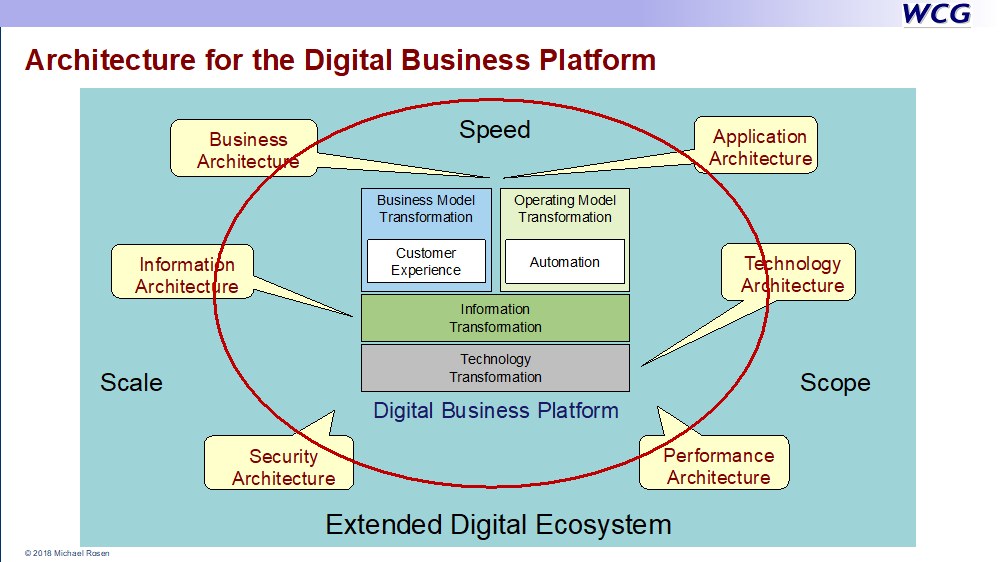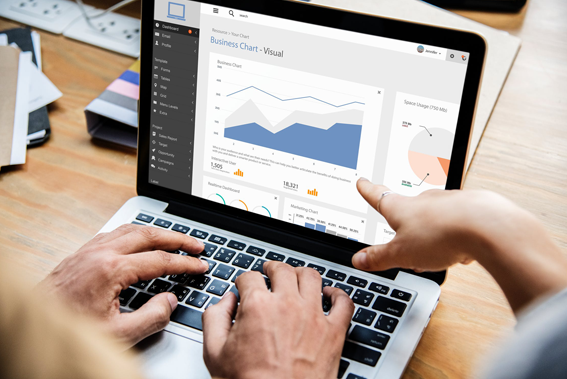Is your organization planning, initiating or undergoing a digital transformation initiative? More than likely, since ever organization today understands that they must address the new digital economy or fall behind. And hopefully, you know how important architecture is to building a sustainable foundation for continued competitiveness.
 Michael Rosen, Chief Scientist, Wilton Consulting Group
Michael Rosen, Chief Scientist, Wilton Consulting Group
Michael will be teaching the course, Architecting the Digital Business Platform 8-9 June 2020, London
He will also be teaching the course, BizOps – Integrating Architecture, Business Analysis, DevOps, Lean, and Agile 10-11 June 2020, London.
Mike will also be speaking at IRM UK’s Business Change and Transformation Conference Europe, 16-18 March 2020, London on BizOps – Integrating Business Change, DevOps, Agile and Architecture
Digital Transformation
So, what is Digital Transformation? Digital Transformation is the application of digital technologies and capabilities to improve the business and operating models of an organization. Organizations that engage in digital transformation typically create new products and services, expand markets, improve efficiency and operations, enhance customer value and experience, engage employees and partners, optimize assets, manage risk, and uncover new monetization opportunities.
I like to think of four aspects of digital transformation, as shown in figure 1. First is the transformation of the business model. New business models extend/improve existing products and services as well as create completely new ones. Examples are:
• Connected products / services / assets – Use connected information for product improvement, predictive maintenance, and to provide users with feedback and recommendations. Examples are remote health devices such as Medtronic’s Continuous Glucose Monitoring system and Caterpillar’s CatConnect product line.
• Platform business model – A platform business model facilitates exchanges between two or more interdependent groups, usually consumers and producers. Platforms create value by harnessing and creating scalable networks of users and resources that can be accessed on demand. Examples are Amazon and Facebook.
• Asset-lite and the sharing economy – Built on top of the platform model, asset-lite, uses the platform to connect owners of assets to those desiring to use the assets. Prime examples are Uber and Airbnb.
• Customer engagement – Provides personalized and targeted interaction with customers that makes them feel “understood, special, part of something” in a way that provides value to the customer and the organization. Examples are Under Armour’s Connected Fitness program and Macy’s On Call mobile shopping assistant.
• Information monetization – Collect information from multiple sources, analyze and aggregate it, anonymize it, and sell the results. Examples are Oracle’s Unified Customer Data and IBM’s Weather Channel Weather Data Packages.
While changes to the business model, and especially to customer interaction are the ‘sexy’ stuff that makes the headlines, changes to the operating model may actually offer more opportunities for organizations to improve their bottom line. Operating models focus on improving internal or partnered operations, efficiencies, and processes. Examples are:
• Digital supply chain
• Intelligent fulfillment
• Decision augmentation
• Robotic process automation
• Digital twin synthesizing
Of course, all of these advances to both the business and operating model are enable by data, and the transformation of that data into insight and knowledge through the use of cognitive technologies (e.g. analytic, AI, ML). And, everything is enabled by the new technologies.
Yet so much has changed in the past 2 or 3 years that it’s hard to know what that should look like anymore. The environment is now part of a larger business ecosystem. Scale, speed, and scope are greatly expanded. Business architecture is different. Information and data architecture are different. Application architecture is different. Technology architecture is different. Security architecture is different. Performance architecture is new. And, how they all fit together to create a “digital business platform” is different too.
 Figure 1 – Architecting the Digital Business Platform
Figure 1 – Architecting the Digital Business Platform
Digital Business Platform
The digital business platform is the new conceptual framework for the architecture that addresses the needs for business model, operating model, information, and technology transformation. Fundamentally, it:
• Supports interaction and communication internally and across the ecosystem
• Has subsystems for collection and storage of large amounts of a wide variety of data in real time
• Provides cognitive capabilities for AI, machine and deep learning, analysis, modeling, visualization
• Enables predictive and prescriptive actions including augmentation, automation, reporting
• Integrates with existing enterprise systems
• Is secure
• Is scalable, flexible, manageable
Figure 2 provides a high-level overview of the key aspects of the digital business platform.
 Figure 2 – Digital Business Platform
Figure 2 – Digital Business Platform
At the heart of the platform is the continuous exchange of data into, out of, and between all aspect of the platform and its environment. Data is collected (in real-time) from customers, partners, connected products, employees and internal processes, IoT devices, supply chains, etc. The intelligent data architecture applies cognitive computing to provide awareness and insights of the ecosystem and translate them in automation, augmented decisions, controls, recommendations and other actions. The application landscape integrates existing enterprise applications with new, microservices based architectures to provide the interfaces, logic, and processes that implement the business and operating models.
Let’s examine some of the architectures that describe the platform and how it is aligned to strategy, designed, and built or provisioned.
Intelligent Data Architecture
The core of the digital business platform is the intelligent data architecture. This is where your organization takes data and turns it into information, knowledge, insight, and most importantly, value. The intelligent data architecture supports:
• Real time data acquisition
• Data storage, management, quality and governance
• Data discovery, modeling, simulation and visualization
• Machine learning
• Analytics processing
• Automation and control
• Reporting and publishing
Business and Information Architecture
Success with digital transformation does not depend on technology alone. Equally important is to have a well-developed strategy, a clearly articulated business and operating model, an understanding of your business capabilities and information, a prioritized and consistent roadmap of execution, and the ability to make intelligent, fact-based decisions quickly. In other words, to have business and information architecture that guides your organization and describes the use of technology for digital transformation. Typical architectural models include:
• Capability map — Defines the business capabilities required to achieve the transformation strategy. Capabilities provide a holistic view across the organization. Capability-based planning allows for optimization at the enterprise level and is effective at mapping strategy to execution.
• Value stream — Defines the exchange of value between the enterprise and external stakeholders. Value streams provide a deeper understanding of engagement, particularly with customers, that allows for trade-offs and prioritization of engagement activities.
• Stakeholder map — Catalogs the set of important internal and external stakeholders of the organization and their relationships.
• Information map — Identifies and defines the important business entities (business objects) that drive business and operating models.
• Data patterns — Provides the detailed logical view of intelligent core components based on transformation and cognitive use cases.
Application and Technology Architecture
In support of the digital business platform and intelligent data architecture are the underlying application and technology architectures. New concepts such as containers, microservices, and APIs support the creation of Functions-as-a-Service (FaaS) and Data-as-a-Service (DaaS). Platform-as-a-Service (PaaS) provides the building blocks to assemble these, while DevOps provides techniques for development and deployment. All of this relies on cloud technologies including IaaS, and hybrid solutions. Typical architectural models include:
• Application reference architecture — Illustrates the model for how applications are implemented and provisioned as part of the digital business platform and specifies a conceptual overview of applications, detailed logical and interaction view, a mapping to specific platform technologies, and deployment details. Each application follows the general model and may create specific models (such as deployment view) for a particular application.
• PaaS mapping — Details how the services and aspects of a specific PaaS platform are used to implement an application (following the reference model).
• Application portfolio — Shows a catalog of all the applications that make up the platform. Keeping track of all the applications is critical for consistency, managing cost and complexity, and managing life cycles.
• Service architecture — Defines the structure of services (microservices) in the platform including guidelines for “enterprise services” versus “local services.” Provides management for a catalog of service APIs.
• Hybrid infrastructure — Defines the cloud infrastructure (typically hybrid) that supports the platform.
Security Architecture
No modern platform would be complete without a security architecture. Not only has the environment, threats and vulnerabilities become greater and more complex, but the context that organizations must operate in also brings new requirements. Security architecture addresses three main components, which combine together to create “Digital Trust” — a new way to think about security.
• Risk – is addressed by applying controls across the traditional security practices that manage identity, trust, vulnerability, and threat. With the realization that it is essentially impossible to protect against all threats and understanding the weakness of most organizations to identify and act on breaches in a timely fashion, the old model of ‘protect and defend’ is outdated and replaced with the newer model of ‘contain and control’.
• Reputation – the external perception of how trustworthy a business is requires managing the organization’s digital brand, its internal and external business and security processes, and the appropriateness of its actions.
• Privacy – managing the protection, control, and reporting of information, such as in accordance with new GDPR requirements.
Security is not just a technology concern. While this has always been true, it is now more important than ever. Business and operating models must take security into account from the beginning if an organization is to be digitally trustworthy.
Well, that’s a quick overview of the digital business platform and an architectural approach to understanding and creating one. I hope it provided some insight and got you thinking about how to apply it to your organization. I’d love the chance to help you explore it in much more detail.
Mike Rosen is Chief Scientist at Wilton Consulting Group providing advice to CIOs, IT Leaders, and Architects on creating the new Digital Business Platform, using architecture as a tool for digital transformation and improved decision making, and aligning architecture with Agile practices. He is also a Founding Member and VP of the Business Architecture Guild, a Certified Business Architect, certified enterprise architect, and Certified Scaled Agilist. Mr. Rosen has more than 35 years of technical leadership experience architecting, designing, and developing solutions, applications, and products, He was previously CTO at startup AZORA Technologies and chief architect, product architect, technical leader, and developer for commercial middleware products from IONA, BEA and Digital. Mr. Rosen is a well-known international speaker and author of 3 books and hundreds of articles.
Copyright Michael Rosen, Chief Scientist, Wilton Consulting Group


